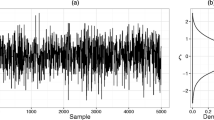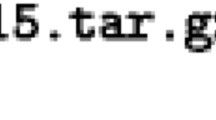Abstract
Comparisons are made between BILOG version 2.2 and LOGIST 5.0 Version 2.5 in estimating the item parameters, traits, item characteristic functions (ICFs), and test characteristic functions (TCFs) for the three-parameter logistic model. Data analyzed are simulated item responses for 1000 simulees and one 10-item test, four 20-item tests, and four 40-item tests. LOGIST usually was faster than BILOG in producing maximum likelihood estimates. BILOG almost always produced more accurate estimates of individual item parameters. In estimating ICFs and TCFs BILOG was more accurate for the 10-item test, and the two programs were about equally accurate for the 20- and 40-item tests.
Similar content being viewed by others
References
Bock, R. D., & Aitkin, M. (1981). Marginal maximum likelihood estimation of item parameters: Application of an EM algorithm.Psychometrika, 46, 443–459.
Hulin, C. L., Lissak, R. I., & Drasgow, F. (1982). Recovery of two- and three-parameter logistic item characteristic curves: A Monte Carlo study.Applied Psychological Measurement, 6, 249–260.
Lord, F. M. (1969). Estimating true-score distributions in psychological testing (An empirical Bayes estimation problem).Psychometrika, 34, 259–299.
Lord, F. M. (1974). Estimation of latent ability and item parameters when there are omitted responses.Psychometrika, 39, 247–264.
Lord, F. M. (1975). The “ability” scale in item characteristic curve theory.Psychometrika, 40, 205–217.
Lord, F. M. (1983a). Statistical bias in maximum likelihood estimators of item parameters.Psychometrika, 48, 425–435.
Lord, F. M. (1983b). Unbiased estimators of ability parameters, of their variance, and of their parallel-forms reliability.Psychometrika, 48, 233–245.
Lord, F. M. (1984).Maximum likelihood and Bayesian parameter estimates in item response theory (RR-84-30-ONR). Princeton, NJ: Educational Testing Service.
Mislevy, R. J. (1984). Estimating latent distributions.Psychometrika, 49, 359–381.
Mislevy, R. J., & Bock, R. D. (1984).BILOG Version 2.2.: Item analysis and test scoring with binary logistic models. Mooresville, IN: Scientific Software.
Qualls, A. L., & Ansley, T. N. (1985, April).A comparison of item and ability parameter estimates derived from LOGIST and BILOG. Paper presented at the meeting of the National Council on Measurement in Education, Chicago, IL.
Stocking, M. L., & Lord, F. M. (1983). Developing a common metric in item response theory.Applied Psychological Measurement, 7, 201–210.
Wingersky, M. S. (1983). LOGIST: A program for computing maximum likelihood procedures for logistic test models. In R. K. Hambleton (Ed.),Applications of item response theory (pp. 45–56). British Columbia: Educational Research Institute of British Columbia.
Wingersky, M. S., Barton, M. A., & Lord, F. M. (1982)LOGIST 5.0 version 1.0 users' guide. Princeton, NJ: Educational Testing Service. (Version 2.5 updated 1984).
Wingersky, M. S., & Lord, F. M. (1973).A computer program for estimating examinee ability and item characteristic curve parameters when there are omitted responses (RM-73-2). Princeton, NJ: Educational Testing Service.
Yen, W. M. (1983). Tau equivalence and equipercentile equating.Psychometrika, 48, 353–369.
Yen, W. M. (1984). Obtaining maximum likelihood trait estimates from number-correct scores for the three-parameter logistic model.Journal of Educational Measurement, 21, 93–111.
Yen, W. M. (1985). Increasing item complexity: A possible cause of scale shrinkage for unidimensional item response theory.Psychometrika, 50, 399–410.
Author information
Authors and Affiliations
Additional information
I am grateful to Robert J. Mislevy, Martha L. Stocking, and Marilyn S. Wingersky for many helpful comments on an earlier version of this paper. I would also like to thank Hamid Kamrani and Bongmyoung Park for getting LOGIST and BILOG running and keeping them running under changing computer systems at CTB/McGraw-Hill.
Rights and permissions
About this article
Cite this article
Yen, W.M. A comparison of the efficiency and accuracy of BILOG and LOGIST. Psychometrika 52, 275–291 (1987). https://doi.org/10.1007/BF02294241
Issue Date:
DOI: https://doi.org/10.1007/BF02294241




